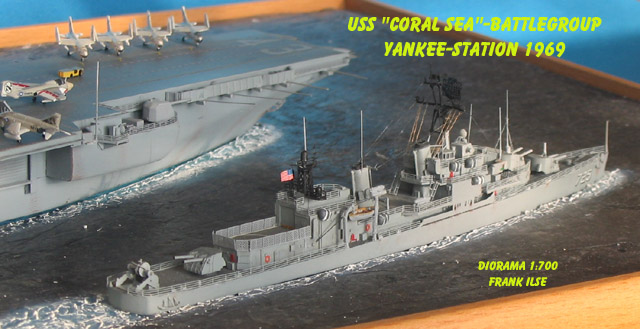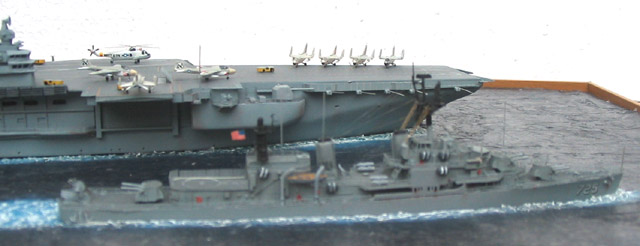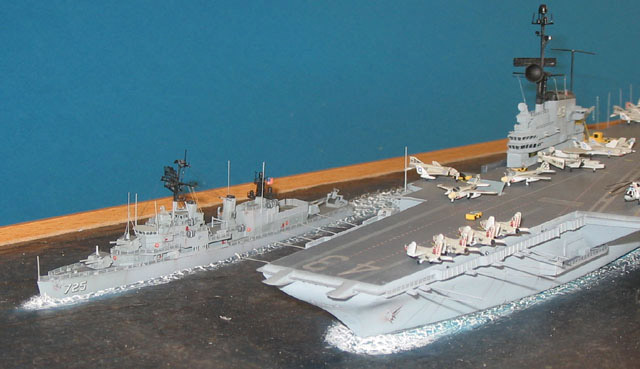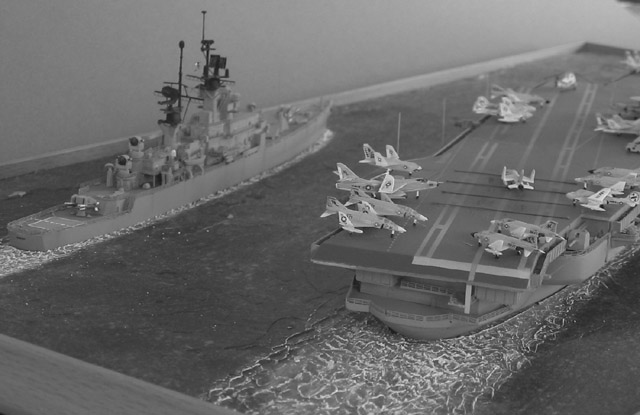| USS Coral Sea Battle Group diorama by Frank Ilse | ||
| Brand: | Scratchbuilt + JAG + Waveline | |
| Scale: | 1/700 | |
| Modeler: | Frank Ilse | |
| AddOns: | Gold Medal Models, spare parts from other kits | |

The
ship:
The
USS Coral Sea was the third so called Aircraft Carrier Large (CVB) that was
constructed taking into account the experiences of WW II. She was ordered from
the Newport News Shipbuilding and Drydock Company on 14 June 1943 and her keel
laid down on 10 July 1944. Launched on 2 April 1946, she was commissioned as
CVB-43 on 1 October 1947. The other two ships of the class were USS Franklin D.
Roosevelt and – giving the name to the whole class of three ships – USS
Midway. Aside of the huge dimensions with 968 feet length, a flightdeck beam of
113 feet and a draft of 35 feet the class featured an armored flight deck and
had a capacity of 125 aircraft, not to mention the 18 five-inch-guns Coral Sea
carried as primary anti-aircraft-battery. Coral Sea spent her early years as
part of the Atlantic fleet with frequent deployments to the Mediterranean.
In
1957 the carrier was sent to Puget Sound Naval Shipyard to undergo a 33-month
conversion and modernization. This SCB 110A included incorporation of an angled
flight deck, hurricane bow, three new steam catapults and the replacement of her
two centerline elevators with three large deckedge elevators. After that
conversion Coral Sea had the dimensions and appearance she remained until her decommissioning
in spring 1990: 978 feet length, flightdeck beam 236 feet and an aircraft
capacity of about 80 modern jets. She was now classified as CV 43.
She was ready to see combat in Vietnam – and she saw a lot of it. Coral Sea deployed to Vietnam seven times and stayed on Yankee station for 875 days. That was one tenth of the total number of days spent in the war zone by the twenty-one attack and antisubmarine carriers ever deployed to the Gulf of Tonkin. After Vietnam Coral Sea remained part of the Pacific fleet with homeports in Alameda and Bremerton until she changed fleets in 1983. New homeport was Norfolk. Over the years she underwent several modernizations and upgrades, concerning her electronic equipment and anti-aircraft armament. She even carried the F-18 “Hornet” as her major aircraft but never hat any “Tomcats” operational. Coral Sea had her last fight in April 1986 when her aircraft were part of the strike against Libya. After that the “maru” got her final nickname: “The ageless warrior”. She is no longer. In contrary to her sister “Midway”, that will become a museum in San Diego, Coral Sea was scrapped in the 90's.

The
idea:
Coral Sea is an aircraft carrier almost everyone runs into when you start modeling jet fighters. She was home for the Sundowners, the Screaming Eagles and the Greyghosts when they were equipped with Phantoms and had some of the most colorful markings. In love warships from the 60's and 70's. Those were the years with a lot of different classes, conversions from old WW II ships and experiments. Coral Sea is a good example for it. Moreover I was impressed by her service record. I had to have her and as there is no model on the market, I had to do it on my own. My first scratchbuilt.

The
model:
Basically
you need the five “P”s to do
this ship: Pictures, Plan, Patience, Putty and Paint. Sometimes I added Pain as
No. Six. Concerning pictures there are several books listed below that provide
pictures. And there is the excellent Coral-Sea-tribute page www.usscoralsea.net
also listed below. That homepage has hundreds of pictures of every period in the
ships life that show her from every side above and even below.
Concerning plans I had an old plan lying around from the time I still did RC model-ships that shows FDR and has the line drawings I needed. Axs the basic hull form is the same, it was good enough for me. For details and further construction I used the excellent drawings in Stefan Terzibaschitsch, Aircraft carriers of the US navy. So I dug out my old slide ruler and made plan drawings for the hull in 1:700, including the very prominent gun sponsons.

a)
hull:
Having done the drawings I started with the ships hull. I decided to use balsa-wood. It worked, but in case I ever do it again I will switch to basswood. It certainly will make handling easier. So there I was with a block of wood in one hand and a knife in the other. It really was that way. I carved out the bow section and the stern first. Then I added the sponsons, also made from balsawood and fixed them with white glue. After all had set an almost endless period of filling and sanding began. It started with a special filler for balsawood then went on to putty to fight the seams. Shots of primer were sprayed over and over again to see, where more work was necessary. After what seemed eternity to me, I finally had a smooth hull. Next came the deck sponson and all the other sponsons and panels around the hull. Enter Evergreen. These sponsons are made from 0,5 mm styrene sheet. After hours of measuring, cutting, measuring again, correction and – of course – sanding it started to look like an aircraft carrier.
b)
deck
Now
it was time for the flight deck. The basic framework is from 3,5 mm styrene
strips, planked with 0,5 mm sheet. This was the first time when pain made itself
felt. The sheet turned out to be too thin for a proper planking. The next day I
had slight waves in my deck. But as they are hardly to be seen I left it that
way. The catwalks turned out to be a real challenge. It was tough to measure and
cut all the curves and angles. Moreover I used the GMM hose reels and catwalk
ladders. They look great once finished but tend to twist your fingers first.
Now
it was time to paint the deck. I sprayed a mixture of modelmasters gloss white
and gloss black enamel first. As a carrier deck shows to all kind of grey shades
once in use, you can start with whatever dark grey you like. Weathering later on
does the rest. Now the deck was masked and hull and catwalks got a coat of dark
ghost grey. After that the decals on the flight deck were applied. I used the
lines from an older Italeri kit of the USS America. They are not top notch, but
cut to size they are ok. Custom red and yellow line was applied around the
elevators. The deck was sealed and weathered with a mixture of dullcote an some
drops of modelmaster gunship gray. The arresting wires are an old G-string high
from my twelvestring guitar. Drybrushing and pastel chalk cared for the rest.
Having finished that part the hull was outfitted with guns, gundirectors, boats and stuff from Skywave frets. Railing and deck nettings are from GMM sets as well as the LSO platform and safety net. I set aside the hull and turned to the
click on the small images to enlarge
c) island
From
my beloved 0,5 mm sheet I cut two side halves with the basic island outline,
including the huge stack. The halves were connected with 3,5mm strips and sanded
to form. Then I moved on to the decks, starting with the navigation- and the
flag bridge. Both were taken from my uncomplaining Italeri-America, cut to size
and glued into place. Prifly went the same way. Then came the vultures rows and
platforms. Doors, hatches, fire-hoses, ladders and railing is from GMM. The mast
ist brass rod in a styrene base, cut and sanded to size. The yardarms are brass-
and styrene rod with GMM railing and footrails. The radar antennas come from the
US supercarrier fret, except the sps 30 highfinder. That’s a leftover from my
JAG “Albany”. Island and mast have about 160 parts in all. The few rig-lines
are fishing line and the flag is wrapped around a tiny piece of aluminum foil to
make her fly in the wind (a trick from Kelly Quirk) The crane was rigged and everything was painted and set
aside, because it was time for the airgroup.
d)
airgroup
I
chose Coral Seas fifth Vietnam deployment in late 1969, because it gives you the
rare opportunity to build a 1:700 carrier with a matching airgroup. It was
airgroup 15 with VF-161, VF-151, VA-35, VA-86 and VA-82 as fighting squadrons.
If you mix Skywave and Fujimi aircraft sets, you get the right decals. Fujimi
provided the Phantoms and Crusaders. Skywave flew in the Corsairs and Intruders
from the Sidewinders and Black Panthers, as well as the Hawkeye. The Skywarrior
is from White Ensign Models. The planes were built, painted and put into place
like the yellow stuff including the tilly with it’s filigrane lattice work
from the GMM fret. A final shot of dullcote – and there she was.

It
took me six months to build my Coral Sea. OK, she is not perfect in every way.
You can always be better next time. But she is unique and she is mine and –
above all – it was great fun to build her. I think, that’s what really
counts in the end. And one day, when patience returnes, I will give her a crew!!
Company
The
carrier is accompanied by USS O’Brien, Allen M. Sumner class, FRAMII. It’s a
JAG-model, resin, very good quality and built straight out of the box. I added
railings from Gold Medal Models (GMM). Second in company is USS Worden, a
Leahy-class guided missile cruiser. This is a Waveline model from Japan. Worden
is built out of the box with GMM railings and radar-details.

References:
USS
Coral Sea (CV 43), Turner Publishing, Paducah 1992, ISBN:1-56311-049-0
Rene J. Francillon, Tonkin Gulf Yacht Club, Conway, London 1988, ISBN:
0-85177-484-9
Stefan
Terzibaschitsch, Flugzeugträger der US Navy, Bernhard und Graefe, München
1978, ISBN: 3-7637-5180-7
Norman
Friedman, US Aircraft Carriers, Naval Institute Press, Annapolis 1983, ISBN:
0-87021-739-9
Photos and text © 2005 by Frank Ilse
www.carrierbuilders.cjb.net